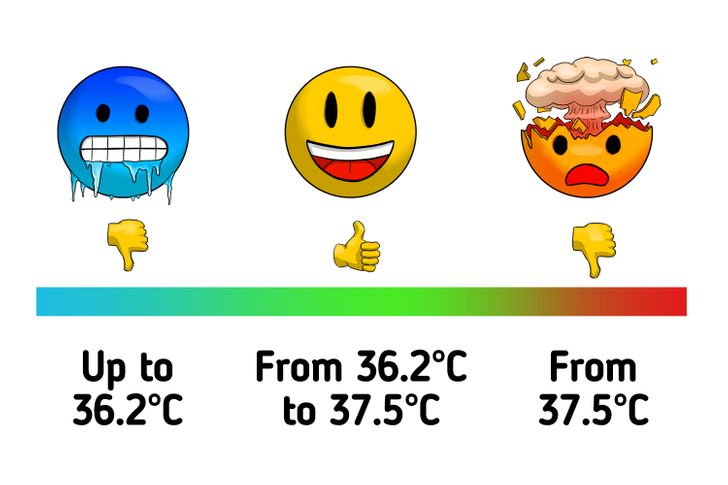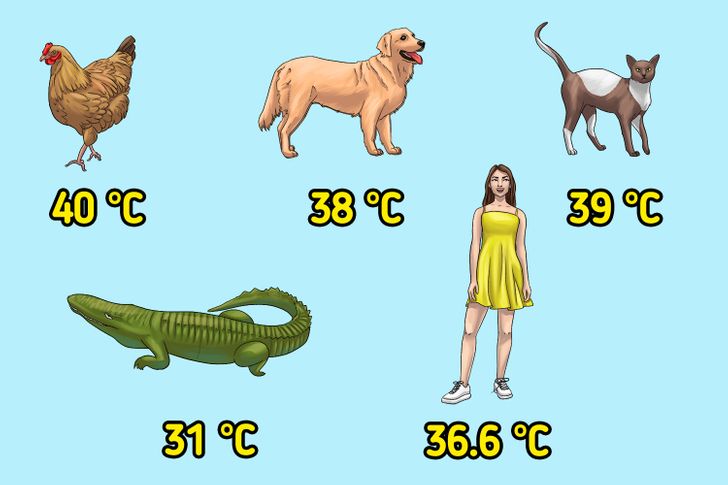Why the Human Body Temperature Is Precisely 36.6°C (98.6°F)
The body temperature of 36.6 °C (98.6°F) is perceived as the norm indicator for humans. But few people know why this indicator has been chosen, who set it, and why it stays the same for people but is different in other living creatures.
5-Minute Crafts collected interesting facts about the temperature of human body.
Why 36.6 °C (98.6°F)

The first mass temperature measuring took place in 1851 in Leipzig. German doctor Carl Reinhold August Wunderlich obtained temperatures from 25,000 residents of the city and set the standard of a normal temperature for the human body — from 36.2 (97.16°F) to 37.5 °C (99.5°F). The arithmetic mean was 36.8°C (98.24°F).
Later, modern research corrected this figure to 36.6°C (98.6°F).
What role the temperature plays in the life of the body

Body temperature is an indicator of how the human body carries out the process of thermoregulation. In extreme heat, the body releases sweat which cools it down. When it’s too cold, we start shivering and the process of warming up is launched. Heat regulation requires a lot of energy, so a warm-blooded person needs several times more food than a cold-blooded python of the same weight.
A person’s body temperature may vary slightly depending on the time of day, and their gender, age, and activity level. But in most cases, the indicator stays close to the usual level of 36.6°C (98.6°F) if they are healthy. Though individual figures can vary between 36.1°C ( 97°F) and 37.2°C ( 99°F) and it’s totally normal.
So why 36.6°C (98.6°F)
This temperature level is considered favorable for humans, but it can be detrimental to other life forms. Today, it’s known that more than 1.5 million species of fungi exist in the world, and most of them cannot withstand temperatures in the range between 30°C (86) to 40°C (104°F). With an increase in body temperature for every 1°C, 6% of fungi, which can infect the body and have a pathogenic effect on it, die.
Thus, our warm-bloodedness is a powerful shield against most existing fungi. While the 36.6°C (98.6°F) body temperature (with small fluctuations) is an ideal balance that lets our bodies not only stay protected from fungi infections but also not spend too much energy on sustaining warmth.
Since fungi prefer low temperatures, they grow well in the organisms of cold-blooded creatures, like bats, fish, and reptiles. Scientists have suggested that fungal intolerance to high temperatures played a role in the Late Cretaceous period. That’s when large reptiles (including dinosaurs) died out, and warm-blooded mammals became the largest surviving predators.
How an increased body temperature protects the body
Another useful property of body temperature is its increase when an infection gets into the body. This defense mechanism seems so familiar, and yet it appeared in living beings relatively recently and has existed for more than 600 million years.
It’s pretty interesting that in the 20th century this ability of the body to warm up was used by doctors to treat various diseases before inventing antibiotics. Although the standards of medicine in those days were different from modern ones, doctors were using observations in their work, realizing that an increased body temperature can suppress a microbe that infected the body.
Can a body temperature change harm the body?
There is a downside as well. A temperature that is too high warms the blood up so much that it affects the central nervous system. And vice versa, a body temperature that is too low slows down the metabolism which, at critically low values, leads to a slowdown in the heartbeat, drowsiness, and loss of consciousness.
There is another assumption from scientists that speaks about the importance of studying the temperature ranges of various types of living creatures. In the perspective of space exploration, the ability to tolerate different temperatures can play an important role in the survival of terrestrial mammals. For example, bacteria from cold Mars may not tolerate a high body temperature. While the thermal limitation of earthlings may not be enough for microorganisms from Venus.
Why different animals have different body temperatures

Different temperatures in living things are explained by differences in their habitats, sizes, masses, metabolic rate, thermal conductivity, and even body shapes. For example, the average normal body temperature in chickens is 40°C (104°F), it’s 38°C (100.4°F) in domestic dogs, 39°C (102.2°F) in cats, and 31°C (87.8°F) in crocodiles.
Large animals can produce more heat than they lose. that’s why it’s easier for them to warm up. For some species, heat loss is proportional to their body surface area, and the amount of heat generated corresponds to their mass. Therefore, for example, white-tailed deer in the Canadian cold are larger than their counterparts in the Florida warmth.
Small animals lose heat faster. Most of them are rounded, which helps them to retain heat inside the body for longer. Examples include various birds and rodents.
How animals can regulate their body temperature
Energy for heating the body is generated by the digestion of food. The smaller the body is and the more heat it loses, the more food it needs to keep warm. That’s why it is easier for birds to migrate south during the cold season. And those of them who stay for the winter try to accumulate more fat during the fall. This allows them to maintain their body temperature at 40 °C (104°F) and keeps them warm in winter.
The cold-blooded representatives of fauna receive heat energy mainly from their external environment. They can eat less, and in order to speed up their metabolism and recharge their energy, they just need to bask in the sun. Their appearance plays its role as well: elongated and flat shapes cool down and heat up faster. For example, the average body temperature of a crocodile is 31°C (87.8°F), but it changes proportionally with its environment — it heats up in the sun and cools down in the shade or in the water.
In addition to the size and shape of the body, all living things have different metabolic rates and thermal conductivity. Therefore, the body temperature of small animals can be higher than that of large animals, since they have a fast metabolism and low thermal conductivity, which compensates for the rapid loss of heat. So, for example, as we said above, chickens have a body temperature of about 40°C (104°F), it is 38.5°C (101.3°F) in Arctic ground squirrels, and only 36.6°C (98.6°F) in humans.